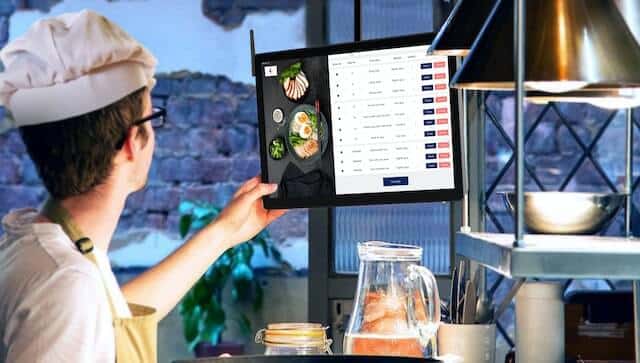Kitchen display systems or KDS are becoming very popular among restaurants because of the many benefits that they offer.
A kitchen display system is a computer monitor that is placed in the kitchen so that the staff can see orders as they come in. This helps to ensure that orders are being prepared correctly and efficiently.
There are several reasons why a kitchen display system is so beneficial for restaurants. From saving inventory costs to reducing customer wait times, KDS can help restaurants in several ways.
In this article, we will be sharing everything you need to know about kitchen display systems and how they can benefit your restaurant business. So whether you are in the restaurant business or are thinking about getting into it, this article is for you.
Table Of Content
What is a kitchen display system?
The Key Features of a Kitchen Display System
10 Reasons why you should consider introducing a KDS
POS vs. Kitchen Display System: Are They the Same?
Final Verdict
What is a kitchen display system?
A kitchen display system or KDS is a simple piece of technology that can have a major impact on your restaurant’s bottom line.
A kitchen display system is a computer and monitors setup that provides your kitchen staff with real-time information about customer orders. KDS systems are often integrated with point-of-sale (POS) systems, so when an order is placed at the front of the house, it is simultaneously sent to the kitchen for preparation.
This real-time information enables your kitchen staff to work more efficiently because they can see exactly what needs to be prepared and when. This, in turn, reduces food waste, speeds up preparation times, and ultimately helps improve your customer satisfaction levels.
While a KDS system may seem like a luxury, it is a very cost-effective way to improve your restaurant’s efficiency and bottom line. Many restaurants see a return on their investment within the first year of installation.
With a KDS and POS system in place, you can be confident that your kitchen is running like a well-oiled machine. This will free up your time to focus on other aspects of running your business and provide peace of mind knowing that your customers are getting their food quickly and accurately.
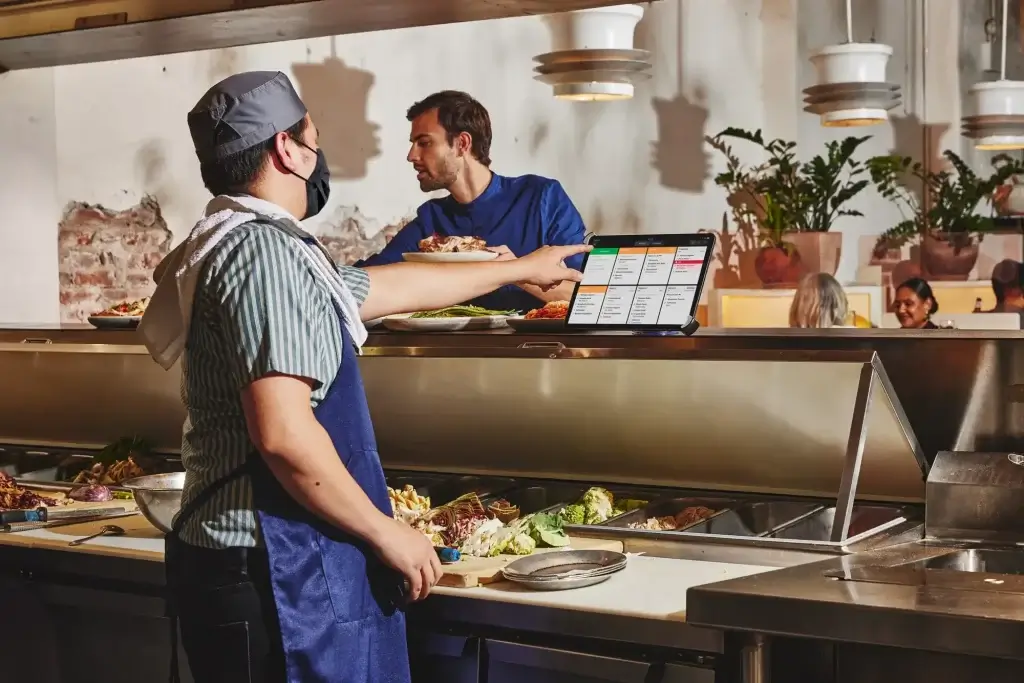
The Key Features of a Kitchen Display System
Here are some of the key features that a KDS machine has to offer:
1. POS integration
POS itself is a great way to manage your restaurant’s inventory, customers, and sales. But when you integrate POS with KDS, you get an even more powerful tool for managing your business.
POS integration enables your front-of-house and back-of-house staff to work together more efficiently by sharing information in real-time.
For example, when a customer places an order, that information is immediately sent to the kitchen so they can start preparing the meal.
This helps to reduce food waste and speeds up preparation times, so your customers don’t have to wait as long for their food.
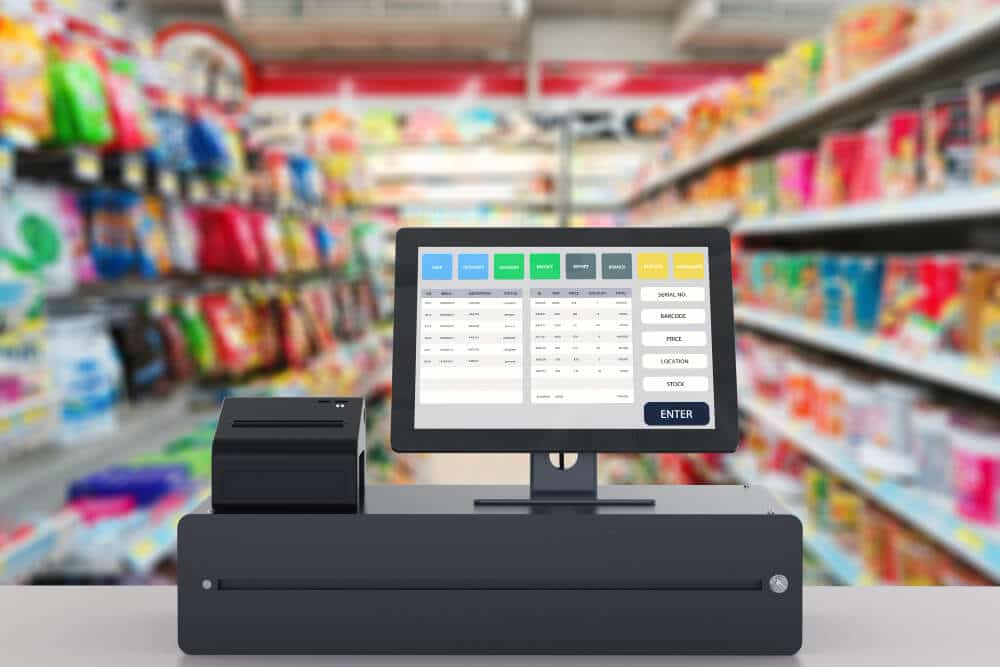
Streamline your business with Octopos– A Complete POS System with Big Boys Tools without the Big Price
It is a lot more than a point of sale. Octopos is easy and intuitive for you and your staff to use. Yet you get all these sophisticated tools to manage inventory, track and engage customers, get meaningful insights into your business, and much more.
Check out the Top 10 Thermal Receipt Printers for your Retail or Restaurant Business POS System
2. Streamlined with your kitchen operations
Another key reason why KDS is essential for restaurants is that it helps to streamline your kitchen operations.
With a KDS system in place, your kitchen staff can see exactly what needs to be prepared and when. This enables them to work more efficiently because they don’t have to waste time looking for information or guessing about what needs to be done next.
It both saves time and reduces the chances of human error, which can be costly in a busy kitchen.
3. Helps you track your business
When integrated with a POS system, KDS also provides valuable data that can be used to track your business.
You can use this data to see which menu items are selling well and which ones need to be tweaked. You can also use it to track your inventory levels and keep an eye on food waste.
This information is essential for making informed decisions about your business and ensuring that your kitchen is running as efficiently as possible.
In addition, it can also help you prepare for taxes because you’ll have a better idea of your sales and inventory levels.
4. Zero delays in order taking
Delays in order taking can reduce the efficiency of your kitchen and cause your customers to become frustrated.
With a KDS system, there is no need to delay taking orders because the information is sent to the kitchen as soon as the customer places their order.
This helps to keep your kitchen running smoothly and ensures that your customers are happy with the service they’re receiving.
5. Online orders can be integrated with KDS
Nowadays, customers expect to be able to order their food online and have it delivered to them or ready for pick-up.
If you’re not offering this option, you’re losing out on potential customers. Fortunately, KDS can help you catch up to your competition.
Online orders get pushed into the KDS automatically if someone places an order online. There is no need to re-enter the information or print it out because it’s all taken care of for you.
This helps to reduce errors and ensures that your customers are getting their food as quickly as possible.
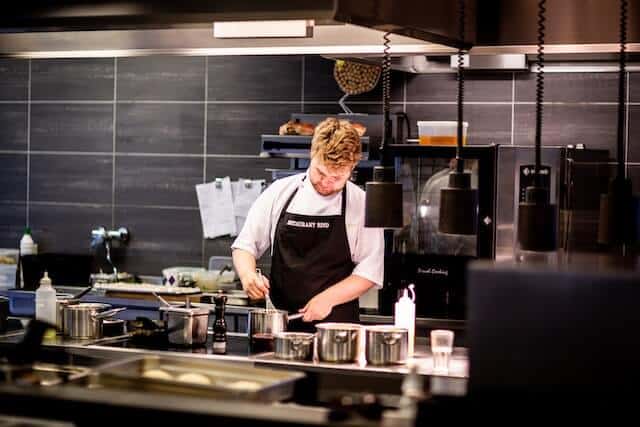
Read Also: How to Start a Ghost Kitchen
10 Reasons why you should consider introducing a KDS
Here are the top 10 reasons why you should invest in a Kitchen Display System:
1. Reduces human error
In a restaurant business, human error is one of the main reasons for inefficiency and high costs. By automating the order-taking process with a KDS, you can reduce the chances of errors and improve your bottom line. This will not only improve your service quality but also keep your customers happy.
2. Increased service speed and efficiency
Your customers expect quick and efficient service, especially during busy hours. With a KDS, your kitchen staff can view all the orders at once and start preparing them immediately. This will help you serve your customers faster and keep them coming back for more. A successful restaurant business is all about providing excellent service and meeting customer expectations.
3. You can control wastage efficiently
Wastage of food not only affects the business budget but is also unethical. Using a KDS, you can keep track of the food items that are running low and need to be replenished. You can reduce wastage by preparing only the required amount of food and avoiding overproduction. This way you can save quite a few bucks as well as do your bit for the environment.
4. Better management of your inventory
As we mentioned earlier integrating a KFD with a POS will give you complete control over your inventory. You can keep track of the stocks and get real-time alerts when they are running low. This will help you avoid any shortages and run your business without any delays and disruptions. To run a successful restaurant business, it is essential to have a well-managed inventory, and having a KDS will make it much easier for you.
5. It’s a one-time investment with long-term benefits
A Kitchen Display System is a one-time investment that will reap benefits in the long run. It may seem like a costly affair initially but it’s worth every penny. The ROI on such systems is quite high and you will start seeing the results within a few months of installation. Most restaurants are considering KDS as a valuable addition to their business.
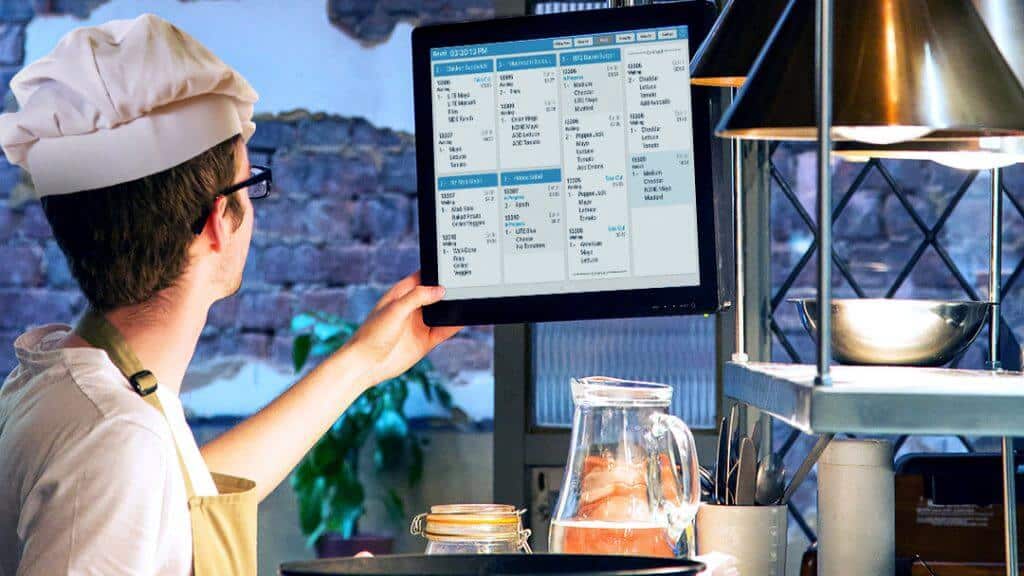
6. Smooth functioning of the kitchen during peak hours
During rush hours, the kitchen can get quite chaotic with orders coming in from all sides. A KDS will help you keep track of all the orders and ensure that they are prepared on time. This way your customers will get their food hot and fresh, just the way they like it. And you can avoid those angry customers and bad reviews.
7. Detailed reporting and analytics
With a KDS, you can generate detailed reports and get valuable insights into your business. You can track your sales, profits, and margins in real-time and make necessary changes to improve your bottom line. This data will help you make informed decisions about pricing, menu planning, and other aspects of your business.
8. Improved communications
With a KDS, you can improve the communication between the front and back of the house. The orders will be sent directly to the kitchen staff without any delays. This way your servers can focus on taking care of the customers and upselling.
Communication is the key when it comes to delivering excellent service. During peak times like lunch and dinner, a KDS can help keep the kitchen organized and prevent any mix-ups.
9. Enhanced customer experience
A KDS will not only improve your service quality but also enhance the overall customer experience. Your customers will appreciate the quick and efficient service and they will be more likely to recommend you to their friends and family.
It will help you attract new customers and retain the existing ones. You will be able to generate more revenue while doing less work.
10. It’s the future of the restaurant business
The kitchen display system is the future of the restaurant business. With the ever-changing technology, it is becoming increasingly essential for restaurants to adopt new systems and stay ahead of the competition.
KDS is one such system that can help you improve your efficiency, reduce wastage, and enhance your customer service. It is an investment that will help you stay ahead of the curve and take your business to the next level.
Installing a KDS is one of the best decisions you can make for your restaurant business. It will help you save money, time, and resources while providing a better experience for your customers. So if you didn’t already have one, we highly recommend you get one installed as soon as possible, you won’t regret it!
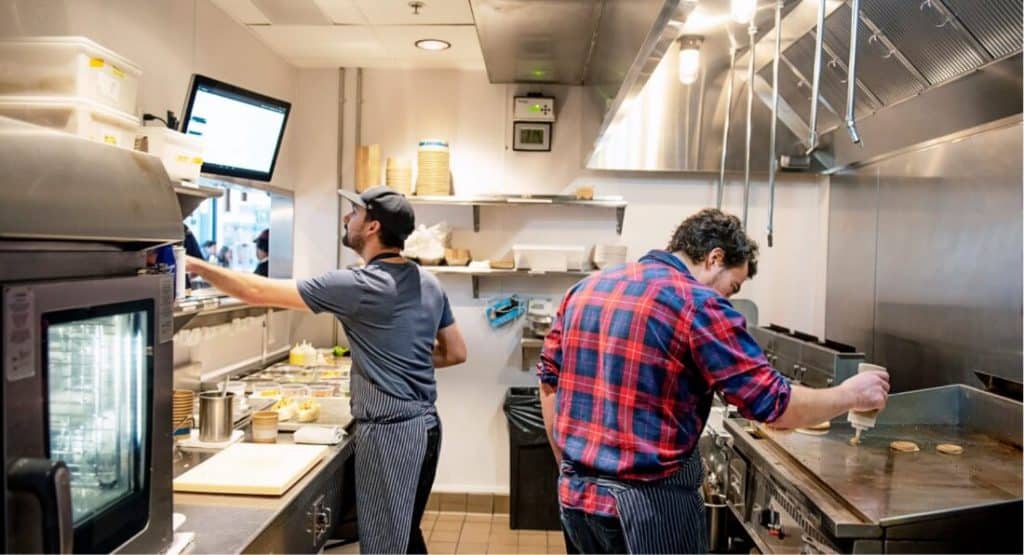
POS vs. Kitchen Display System: Are They the Same?
No, POS and Kitchen Display Systems are not the same. However, they can be closely integrated, which can make people think they are the same.
But both POS and KDS serve different purposes. Let’s take a closer look at what POS is and how it works!
What is a POS system?
A POS or Point of Sale system is used to record customer orders and process payments. A POS system can be as simple as a cash register or as sophisticated as an iPad with an integrated credit card reader.
In simple words, POS is used to record what the customer wants to buy and process the payment for it. It is a well-managed system in which the restaurant owner can see what is being ordered, how much is being ordered, and from where most of the orders are coming.
How does a POS system work?
A POS system is usually composed of two parts: software and hardware. The software is used to record customer orders and process payments. It is also used to generate reports and track inventory.
The hardware includes the devices that are used to input the customer’s orders and process payments. These can be anything from a traditional cash register to an iPad with a credit card reader.
Difference Between POS and KDS
As you can see POS and KDS are two completely different systems. POS is used to record customer orders and process payments. Whereas, KDS is used to send orders directly to the kitchen staff and keep track of the progress.
POS systems are usually composed of software and hardware. The software is used to record customer orders and process payments. It is also used to generate reports and track inventory. The hardware includes the devices that are used to input the customer’s orders and process payments.
KDS, on the other hand, is mostly software-based. It is used to send orders directly to the kitchen staff and keep track of the progress. It can be integrated with POS systems to make things easier.
When integrated, POS and KDS can be powerful tools for any restaurant business!
FAQ
How much does a kitchen display system cost?
A KDS is a machine that shows orders for the cooks. It can cost $10-$25 per month plus the cost of buying the machine. Most restaurants should use a KDS because it helps the cooks know what to make next, even in small kitchens.
Now when it comes to the machine itself, the cost varies depending on the features you need. A basic machine with minimal features can cost anywhere from $1,000 to $2,500.
But if you need more sophisticated features like a touchscreen or special software capabilities, then it can cost up to $3,000 or more.
For restaurants that want multiple KDS systems in one kitchen, the cost can be higher. You’ll need to purchase multiple machines and pay for additional software subscriptions.
What Are The Different Types Of Kitchen Display Systems?
There are two main types of KDS: hardware-based and software-based.
Hardware-based systems require a physical machine, such as a computer or tablet with a dedicated software program installed on it. These systems are typically used for small kitchens where cost-effectiveness is important.
Software-based systems, on the other hand, are web-based and can be used from any device with internet access.
These systems offer more features than hardware-based systems but require a monthly subscription. They’re typically used in larger kitchens where you need more sophisticated capabilities.
Finally, there are hybrid systems that combine both hardware and software elements. This is usually the best option for restaurants that want to use both types of KDS systems. They can get the cost-effectiveness of a hardware system with the features of a software system.
How to Decide If A KDS Is Right for Your Business?
There are several factors to consider when deciding if a KDS is right for your business. First, you need to determine the size of your kitchen and whether or not you will benefit from having multiple systems in one place.
Second, you should consider the features that are important for your specific needs. Does it have touchscreen capabilities? Is there special software needed?
Third, you should compare the cost of both hardware-based and software-based systems. Look at both the upfront purchase price and any monthly or annual subscription fees that may be required.
Finally, consider the long-term benefits of a KDS system such as increased efficiency and reduced labor costs. If these are important to
Third, you should compare the cost of both hardware-based and software-based systems. Look at both the upfront purchase price and any monthly or annual subscription fees that may be required.
Finally, the pricing should always be taken into consideration. Compare the cost of different KDS systems to find one that fits your budget.
How Does KDS Work?
A KDS is a computer system that is used to display orders for the kitchen staff. It can show current and upcoming orders, as well as customer preferences. This helps the kitchen staff stay organized and keep track of what needs to be made.
KDS systems are typically connected to a POS (Point of Sale) system to receive orders from the waitstaff. Once an order is received, the KDS will display it on the screen for the kitchen staff to view.
KDS systems also have other features such as timers, which help cooks know how long each order has been cooking.
This helps them keep their food quality consistent and reduce waste. Additionally, some KDS systems allow managers to monitor labor costs and track inventory levels.
Final Verdict
So there you have it! Now you know everything you need to know about KDS! As you can tell by now, KDS can be a great addition to your restaurant business. It’s becoming increasingly essential for restaurants to adopt new systems and stay ahead of the competition. KDS is one such system that can help you improve your efficiency, reduce wastage, and enhance your customer service.

